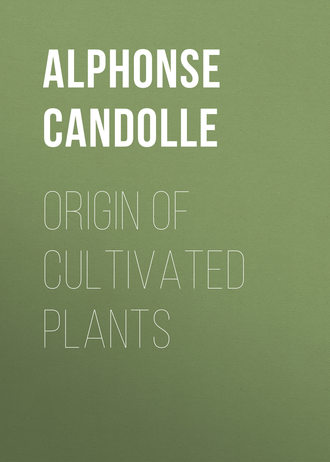 полная версия
полная версияOrigin of Cultivated Plants
2147
Blanco, Fl. di Filipinas, edit. 2.
2148
Da Mosto, in Ramusio, i. p. 104, quoted by R. Brown.
2149
Brown, Bot. of Congo, p. 55.
2150
Martius, Hist. Nat. Palmarum, ii. p. 62; Drude, in Fl. Brasil., fasc. 85, p. 457. I find no author who asserts that this palm is wild in Guiana, as Martius affirms it to be in Brazil.
2151
Elæis melanocarpa, Gærtner. The fruit also contains oil, but it does not appear that the species is cultivated, as the number of oleaginous plants is considerable in all countries.
2152
Sloane, Nat. Hist. of Jamaica, ii. p. 113.
2153
Grisebach, Flora of Brit. W. Ind. Is., p. 522.
2154
Piso, Brasil., p. 65; Marcgraf, p. 138.
2155
Martius, Hist. Nat. Palmarum, 3 vols. in folio; see vol. ii. p. 125.
2156
Aublet, Guyane, suppl., p. 102.
2157
Sloane, Jamaica, ii. p. 9.
2158
J. Acosta, Hist. Nat. des Indes, French trans., 1598, p. 178.
2159
Vafer, Voyage de Dampier, edit. 1705, p. 186; Vancouver, French edit., p. 325, quoted by de Martius, Hist. Nat. Palmarum, i. p. 188.
2160
Seemann, Bot. of Herald., p. 204.
2161
Hernandez, Thesaurus Mexic., p. 71. He attributes the same name, p. 75, to the cocoa-nut palm of the Philippine Islands.
2162
Oviedo, Ramusio’s trans., iii. p. 53.
2163
A. de Candolle, Géogr. Bot. Raisonnée, p. 976.
2164
Grisebach, Vegetation der Erde, pp. 11, 323.
2165
Seemann, Flora Vitiensis, p. 275.
2166
The cocoa-nut called Maldive belongs to the genus Lodoicea. Coco mamillaris, Blanco, of the Philippines is a variety of the cultivated Cocos nucifera.
2167
Drude, in Bot. Zeitung, 1876, p. 801; and Flora Brasiliensis, fasc. 85, p. 405.
2168
Stieler, Hand Atlas, edit. 1867, map 3.
2169
Stieler, ibid., map 9.
2170
Grisebach, Flora of Brit. W. Indies, p. 552.
2171
Eugène Fournier has indicated to me, for instance, drdapala (with hard fruit), palakecara (with hairy fruit), jalakajka (water-holder), etc.
2172
Blume, Rumphia, iii. p. 82.
2173
Forster, De Plantis Esculentis, p. 48; Nadeaud, Enum. des Plantes de Taiti, p. 41.
2174
Blume, ubi supra.
2175
Bretschneider, Study and Value, etc., p. 24.
2176
Seemann, Fl. Vitiensis, p. 276; Pickering, Chronol. Arrangement, p. 428.
2177
Dr. Bretschneider writes to me from Pekin, Dec. 22, 1882, that the species is mentioned in the Ryd, a work of the year 1100 B.C. I do not know if we must suppose the original habitat to be China or western Asia.
2178
Essai sur la Géographie des Plantes, p. 28.
2179
Counting two or three forms which are perhaps rather very distinct races.
2180
See the list of the useful plants of Australia by Sir J. Hooker, Flora Tasmania, p. cx.; and Bentham, Flora Australiensis, vii. p. 156.
2181
The proportions which I give for the Phanerogams collectively are based upon an approximative calculation, made with the aid of the first two hundred pages of Steudel’s Nomenclator. They are justified by the comparison with several floras.
2182
The species in italics are of very ancient cultivation (A or D), those marked with an asterisk have been less than two thousand years in cultivation (C or F).
2183
Since this list was printed, I have been informed that the quinoa is wild in Chili. Some of the figures need modification in consequence of this error.
2184
For reasons which I cannot here express, monotypical genera are for the most part in process of extinction.



